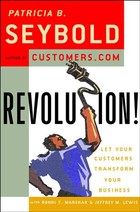The Customer Revolution Is Coming Back!
Customers Are on the Cusp of Retaking Control Over the Big Things that Impact Their Lives
The next customer revolution is upon us. We’ll regain control of the things that matter most in our lives: our government, our financial well-being, our health, our jobs, our privacy, and our access to the Internet. We’ll develop alternatives to the broken ecosystems that are not aligned around customers, citizens, and patients’ needs. We’ll migrate towards customer-to-customer bartering and sharing models. We’ll support businesses that provide peer-to-peer exchanges.
NETTING IT OUT
When the Internet came of age in the late 1990s and early 2000s, customers gained more power. Customers’ were no longer in the dark. They became empowered with information, and with the ability to damage brand reputations in a few hours.
The Customer Revolution that took place in the early 2000’s as a result of Internet empowerment transformed many industries dramatically. Customer empowerment helped many businesses, and government organizations become more customer-focused. Customers’ behaviors in their use of digital media have dramatically reshaped how we do things.
Yet, today, we are on the cusp of another Customer Revolution. Globally, we have experienced a dramatic increase in financial inequality, an increase in legalized corruption, and an increase in the abuse of power.
What’s coming is not a political movement. It’s another shift in the balance of power. There are a number of large ecosystems that are out of balance because customers/citizens are no longer in the center (or at the top layer, in “customer scenario” terms). But, as before, customers will take control. They will either alter these ecosystems by exerting control, or they’ll create parallel ecosystems and the old ones will wither away.
It will come as no surprise that empowering customer-to-customer (peer-to-peer) transactions is one of the drivers of this next customer revolution.
CUSTOMERS HAD A LOT MORE CLOUT A DECADE AGO
Customers Gained Control and Transformed Industries, Thanks to the Web
When we published The Customer Revolution in 2001, it marked a turning point in our economy. That was a time when, thanks primarily to the Internet and the Web, customers had unprecedented clout. Customer behavior was disrupting entire industries.
Customers Transformed the Music Industry. Remember Napster? Before Apple legitimized the pay-per-song/download model, the only way most people could download and mix and match their favorite tracks of music was to steal them. In the early 2000’s, customers’ renegade behaviors reshaped the entire music industry and, to a broader extent, how we use and buy digital media.
What did those renegade music lovers do? They converted music to electronic form so they could share it with their friends. They discovered and listened to new music and new artists by downloading those digital files. They created their own music mixes, rather than purchasing albums. They broadcast their own mixes on radio stations of their own creation. Customers took control. They began consuming music differently. They created new patterns of use.
Now, over a decade later, we expect to be able to download tracks of music, to mix and match, to create our own customized playlists and radio stations. New businesses and new business models have emerged in response to customers’ behaviors.
Customers Demanded Transparent Pricing. Product pricing in most industries used to be more opaque before the Web. I remember talking with Cisco Systems’ CEO John Chambers in 2000, and he was one of the first executives to admit that his company would no longer be able to sustain the practice of charging different prices for the same products in different countries because online shoppers were doing cross-border price comparisons.
Now, more than a decade later, customers can price-compare instantaneously. People walk down the aisles at stores, use their mobile phones to scan the code on any product, and immediately see where the same product might be purchased for less money. Then they can make the trade-offs between convenience and price.
Customers Became Sellers, as well as Buyers. Before Meg Whitman even heard of eBay, that company was disrupting entire industries. Customers were buying and selling the contents of their attics, their crafts, their cars, and making a living catering to seekers of collectibles. Pierre Omidyar’s simple e-market had created a peer-to-peer industry...(more)
(Download the PDF to read the entire article.)
Sign in to download the full article
0 comments
Be the first one to comment.




